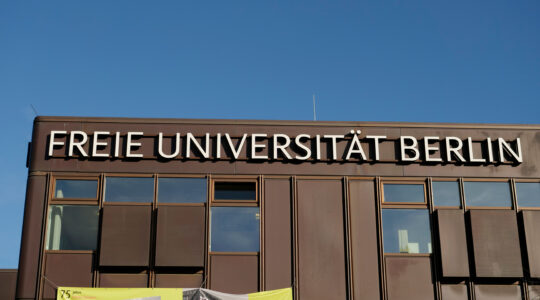DNEPROPETROVSK, Ukraine (JTA) – With the cautious enthusiasm that pervades his community, Rabbi Shmuel Kaminetsky quotes from Psalms, “Those who sow in tears shall reap in joy.”
The harvest is coming to Dnepropetrovsk, long considered the most organized Jewish community in the former Soviet Union. Now it’s the site of myriad construction projects that surely will change the landscape in Ukraine and put the city back on the map of world Jewry.
Kaminetsky, the 43-year-old Chabad emissary who spurred the first wave of growth here after his arrival in 1990, now wants to do it all over again.
The local Chabad community estimates that there are 50,000 Jews living here. In Kiev, the capital of Ukraine, estimates run between 70,000 and 100,000 Jews.
In Dnepropetrovsk, several factors have aligned to trigger a second wave of development. The centerpiece is the planned Menorah Center – at nearly 400,000 square feet it would be the largest community center in the former Soviet Union and perhaps the world.
The 20-story building with seven terraced roofs will tower above the existing synagogue on Shalom Aleichem Street, casting the shadow of a menorah on the tree-covered hills leading down to the Dnepr River.
Construction began last month on the $70 million tower.
Three of Ukraine’s four richest men are members of the city’s Jewish community and they have bankrolled a raft of construction projects. Two partners in the Privat group industrial holding, Gennady Bogolubov and Igor Kolomoysky, are funding the center and an attached Holocaust museum, respectively.
Community leaders say the billionaires, including metals magnate Viktor Pinchuk, have bought into the idea of giving back to the local Jewish community, a relatively new and sporadic development in the former Soviet Union.
Bogolubov is the president of a meticulously organized community parliament with 60 members, seven committees, a chief executive and a $7 million annual budget.
Kaminetsky recalled with delight a recent Shabbat spent in Vienna at Bogolubov’s second, glatt kosher home. They walked 40 minutes together to the synagogue and studied Torah, the rabbi said.
“The idea is to identify who can do what the best way, and squeeze them out and use them up as maximum as possible, in a good way,” Kaminetsky told JTA in his office overlooking the construction of the new center.
The Menorah Center will house the headquarters of Bogolubov’s charitable foundation on its top floor, as well as the nerve center of the Ukraine-wide Federation of Jewish Communities and a host of local organizations.
Alexander Sorin, the architect of the tower, is the son of a prominent Soviet-era architect who designed many of the major buildings in this industrial city. Foreigners stayed away during the Soviet era because of weapons technology research and construction facilities.
The first floor leading through the Holocaust museum and the center will resemble a Jerusalem alleyway with brown stone and a slightly claustrophobic feel, Sorin said.
The center will have a kosher hotel and lobby with an elevator programmed to allow observant passengers to ride on Shabbat. The community is seeking an independent contractor to run the hotel.
There will be apartments for visiting Jewish educators and community workers, as well as office space to rent for Jewish-related entities such as the Jewish Agency for Israel, an Israeli consular office and other organizations.
The Holocaust museum will feature the research of a group of scientists known as Tkuma, or “resurrection” in Hebrew, who have been collecting testimonies, artifacts and names of the 11,000 Jews killed by the Nazis in Dnepropetrovsk on Simchat Torah in 1943.
The museum will accompany a sprawling monument in a local park with dozens of stones engraved with victims’ names.
Activities run by the Dnepropetrovsk Jewish community are spread out across dozens of buildings. The Menorah Center will centralize that activity, though most outlying facilities will remain.
Kaminetsky keeps his office in a small annex off the main synagogue. The community’s chief executive, Vyacheslav Brez, is down the road in the back lot of a synagogue, the city’s only continuously running Jewish building that is tucked between two wings of a towering shopping center.
Brez manages the community’s projects all over town: a Jewish day school, kindergarten, old-age home and yeshivas filled with local Jews.
In building this infrastructure, Dnepropetrovsk took its cues – and a portion of its funding – from Boston’s Combined Jewish Philanthropies. Ten years of shared knowledge and work have brought Dnepropetrovsk to where it is today, but Brez says the locals have taken over and now projects like the community center provide hope.
“It gives us gasoline to keep going,” Brez said. “This is very hard work.”
It seems as though every Jewish building in Dnepropetrovsk is recently constructed or under construction, or blueprints are spread across the desks in older buildings.
“Our community is a monolith. This Menorah building is just what we need,” said Anna Kaplunskaya, the director of a Jewish day school that is being overhauled.
Another example is Beit Hanna, a college dedicated to training women to become Jewish educators and a school for special-needs children.
Tamara Olychantskaya, the institute’s director, stood before a map of the former Soviet Union dotted with LED lights, flipping switches in turn, one from where their students originated, one for where they went after graduating, one for each school under their umbrella. From Belarus to the Pacific Ocean, the board lit up like a switchboard.
Soon those students and teachers will come from all over to a new technology center and dormitory. The center’s founder, Mayer Stambler, has plans to build a new center starting in 2009 that would draw even more than the school’s 140-plus students to Dnepropetrovsk.
The center will cost $15 million to $20 million and be paid for partially by selling community assets – another piece of this second wave of development.
Walking through the halls of old-age homes, schools and synagogues, portraits of the seventh Lubavitcher rebbe, Menachem Mendel Schneerson, stare down from the walls and shelves.
Dnepropetrovsk was his home before he fled the Soviet Union. His father was arrested 50 yards from where the community is now rebuilding the facade of his home and placing a memorial.
Kaminetsky said the rebbe wanted to see the community revived, a source of pride for the Chabad movement worldwide and a new center of gravity for the emissaries and local adherents that dominate much of Jewish life across the former Soviet Union.
“For many Chabadniks in the whole world, Dnepropetrovsk is a very special place because of the history,” Kaminetsky said. “We give the rebbe all the credit because he sent me here and he gave me a plan, and he told me how to work and he gave us blessings.”
JTA has documented Jewish history in real-time for over a century. Keep our journalism strong by joining us in supporting independent, award-winning reporting.





